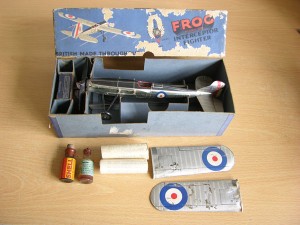FROG, which stands for Flies Right Off the Ground, can be traced back to 1932 when the company & trademark were first registered by two brothers John and Charles Wilmot and their friend Joe Mansour. The trio set about developing a small range of ‘Ready to Fly’ 1:32 scale planes with duralin fuselages, paper wings and a propeller driven by an elastic wound mechanism housed within the end of each box. The first FROG was a pre-built model of the Interceptor Mk IV in a RAF configuration (later Belgian, Italian, Dutch, American versions were introduced, together with a model with skis). A marketing & distribution alliance with Lines Brothers (Tri-ang Ltd.) through their International Model Aircraft Company enabled them to bring the model to market and ultimately resulted in FROG becoming part of the toy giant.
However FROG’s ‘eureka’ moment occurred in 1935 when the trio experimented with a new material, cellulose acetate, which was in the advanced stage of testing by SKYBIRDS. This lightweight and much stronger material opened up a whole lot of new opportunities to the company and in 1937 FROG launched their now highly sought after range of factory built and model kit form PENGUIN series models, becoming the very first plastic kits to be made.
The picture shows an early Frog Interceptor Mk IV complete with winder mechanism
More information can be found in our Tri-ang Toys Price Guide





